Damselfish are a type of saltwater fish that are popular among aquarium enthusiasts. These vibrant fish are relatively easy to care for and make a beautiful addition to any tank. There are many different species of Damselfish, each with its unique appearance and personality.
They are found in tropical waters all around the world. They typically inhabit reefs or other areas with plenty of hiding places. This is because they are very territorial and often defend their territory aggressively against other fish.
There are many different species, each with its unique coloration and patterning. The most popular among aquarium enthusiasts are the blue, yellowtail Damselfish, and clownfish.
Damselfish belong to the Pomacentridae family, and there are around 300 species. Most of these species are saltwater fish in the Indian and Pacific Oceans. Their natural environment is in tropical coral reefs, and they are lively and active fish.
It isn’t “bulletproof” but can tolerate poor water conditions if you make a cycling mistake. The Blue Damselfish is territorial and will become aggressive if a fish intrudes on its patch; it will chase and nip at subordinate fish.
Damselfish are relatively easy to care for and make a beautiful addition to any saltwater aquarium. With proper care, these vibrant fish can provide many years of enjoyment. Most are omnivorous and will feed on a variety of meaty foods as well as plant matter.
This article will discuss everything you need to know about Damselfish, including their natural habitat, diet, and care requirements.
Table of Contents
Species Summary
| Scientific Name: | Chrysiptera hemicyanea |
| Family: | Pomacentridae |
| Lifespan: | 5-6 years |
| Size: | 3-12 inches |
| Care Level: | Easy |
| Water Temperature: | 72°-79°F |
| Temperament: | Aggressive |
| pH: | 8.1 to 8.4 |
| Color Form: | Various |
| Diet: | Omnivore |
| Minimum Tank Size: | 30 gallons |
| Tank Set-Up: | Marine: coral or rocks |
| Reef Compatible: | Safe |
Damselfish Appearance
The appearance of Damselfish varies depending on the species. Blue Damselfish are, as their name suggests, blue. Yellowtail Damselfish are yellow with a black stripe running down their back. Clownfish are orange with white stripes.
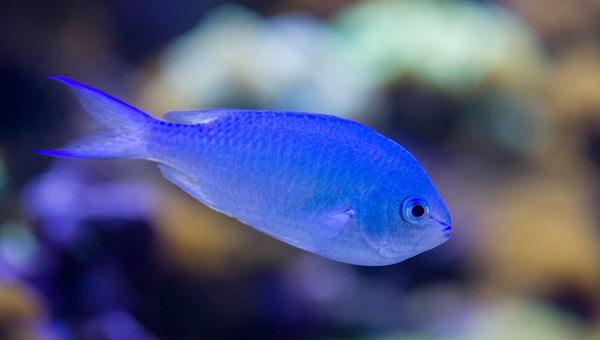
Damselfish have a variety of different patterning and coloration. Blue Damselfish has either vertical or horizontal stripes. Yellowtail Damselfish have a black stripe running down their back and spots on their sides. Clownfish have white stripes against an orange background.
The vast majority of Damselfish are brightly colored. This is thought to be a form of camouflage, as the bright colors allow the fish to blend in with the colorful coral reefs where they live.
It’s important to note here, though, that some Damsels are very colorful as juveniles and lose their color as they age; some can even end up utterly brown once they mature. So make sure to research before buying.
Also, check How To Cure Fish Fungus (Aquarium Fish) Ultimate Treatment & Medication
Damselfish Size and Growth Rate
The size of Damselfish varies depending on the species. Blue Damselfish typically grow to be 3-4 inches. Yellowtail Damselfish can grow to be 6-8 inches. Clownfish are usually the minor type and only grow 2-3 inches.
Damselfish Lifespan
The average lifespan is 5-6 years. However, some species of Damselfish have been known to live up to 10 years and even longer in captivity.
Popular Varieties of Damselfish
Following are some popular varieties of Damselfish with brief descriptions:
- Blue Damselfish (Pomacentrus coelestis): Blue Damselfish is the most common type of Damselfish. It is a small fish, growing to be only 3-4 inches long. As its name suggests, the blue Damselfish is blue with either vertical or horizontal stripes. These fish are easy to care for and add to nano and regular aquariums.
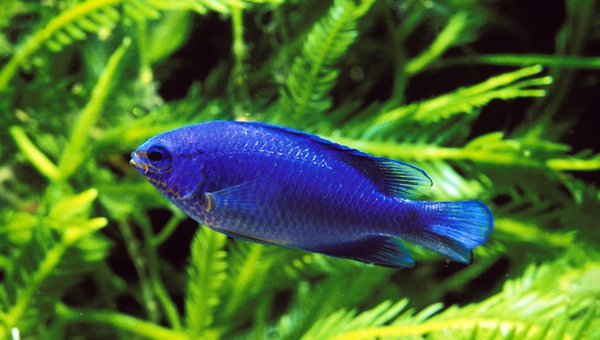
- Yellowtail Damselfish (Chrysiptera parasema): The yellowtail Damselfish is a brightly colored fish that grows 6-8 inches long. It is yellow with a black stripe running down its back and spots on its sides. Yellowtail Damselfish are easy to care for and add to nano and regular aquariums.
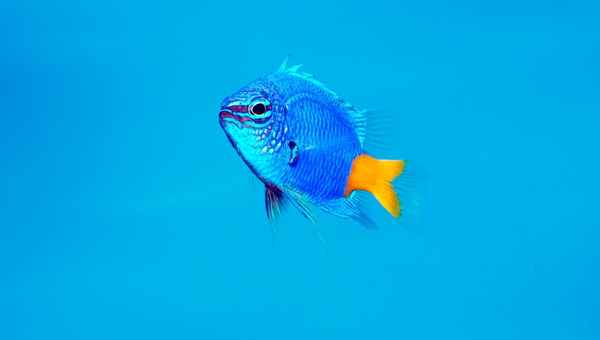
- Clownfish (Amphiprion ocellaris): Clownfish are the most popular type of Damselfish, thanks partly to Finding Nemo. These fish are orange with white stripes and only grow 2-3 inches long. Clownfish are easy to care for and add to nano and regular aquariums.
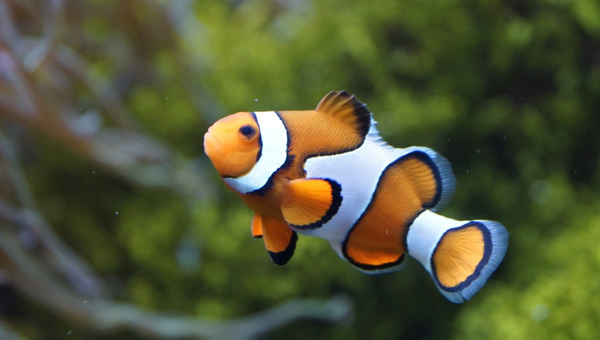
- Azure Damselfish (Chrysiptera hemicyanea): The azure Damselfish is a beautiful blue color with yellow fins. It grows 4-6 inches long and is a straightforward fish to care for. Azure Damselfish make great additions to both nano and regular aquariums.
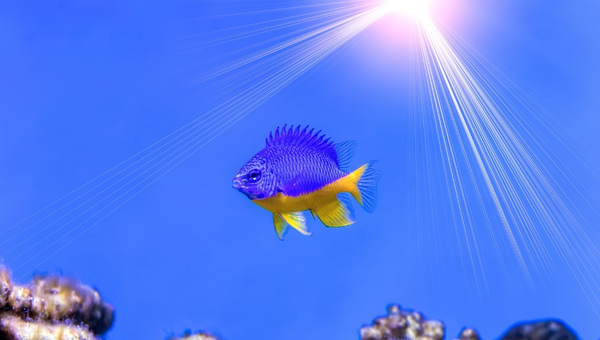
- Bicolor Damselfish (Chrysiptera biocellata): Bicolor Damselfish is a beautiful blue and yellow color. It grows 4-6 inches long and is a straightforward fish to care for. Bicolor Damselfish make great additions to both nano and regular aquariums.
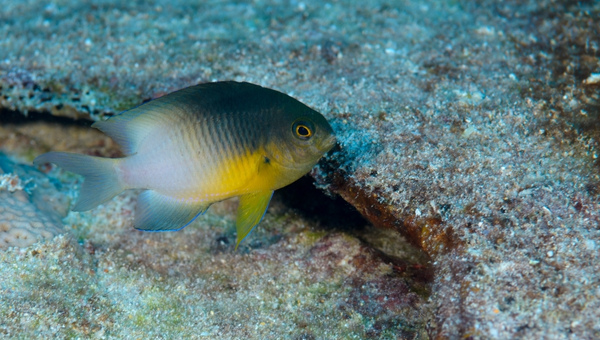
Damselfish Behavior and Temperament
These fishes are aggressive and territorial. They are not recommended for community tanks. It is best to keep them with other aggressive fishes such as triggers, puffers, and wrasses.
These fishes are also known to eat smaller fishes and inverts. So, avoiding keeping them with smaller fishes and inverts is best.
Thus, these fishes are not recommended for beginners.
Also, check Tomini Tang Fish Care Guide: Appearance, Breeding & All
Damselfish Breeding
Most Damselfish lay their eggs in a nest made of algae, coral rubble, or rock. Others scatter their eggs among the corals. A few species are mouthbrooders, carrying the eggs in their mouths until they hatch. The parents often fiercely protect their young.
The larvae of many Damselfish species are planktonic, drifting along in the water column until they settle out onto the reef and undergo metamorphosis into juveniles.
Some species have pelagic eggs and larvae that never settle onto the reef but remain free-swimming their entire lives. These “open ocean” Damselfish often have a much more comprehensive geographic range than their reef-dwelling cousins.
Most Damselfish are sequential hermaphrodites, meaning they start life as males and later change sex to female. This ensures that there is always a male present to fertilize the eggs laid by the female. A few species are permanently male or female.
Also, check Twig Catfish (Farlowella acus) 101: Best Detailed Care Guide
Damselfish Care Guide
Damselfish are easy to care for and make great additions to nano and regular aquariums. These little fish are hardy and can tolerate a wide range of water conditions but prefer tropical temperatures between 72° to 79°Fahrenheit. They also need moderate to high lighting and plenty of hiding places.
Damselfish are active swimmers who do best in aquariums with plenty of open swimming space. They can be territorial towards their species and other fish, so it is best to keep them singly or in pairs unless the aquarium is large enough to accommodate a small group.
Thus, when considering what other fish to add to your Damselfish aquarium, it is best to choose peaceful tank mates that are not too small (Damselfish have been known to eat tiny fish). Some good examples of compatible fish include dotty backs, cardinalfish, basslets, and wrasses.
Damselfish Food and Diet
These fishes are omnivores, meaning their diet should be high in protein. A good diet for these fishes includes:
Live foods such as brine shrimp, bloodworms, and daphnia; frozen foods such as mysis shrimp and krill and pellets or flakes high in protein.
It is also a good idea to feed your fish a variety of food to ensure they get all the nutrients they need.
Following are some excellent food choices for these fishes which provides protein:
- Brine shrimp
- Bloodworms
- Daphnia
- Mysis shrimp
- Krill
- Pellets
- Flakes
Damselfish Tank Mates
Some good tank mates for these fishes include:
- Triggers: Triggers are aggressive fishes that can hold their own against Damselfish.
- Puffers: Puffers can hold their own against Damselfish because they are aggressive fishes.
- Wrasses: Wrasses are also able to hold their own against Damselfish.
Some bad tank mates for these fishes include:
- Smaller fishes: Smaller fishes will be eaten by Damselfish.
- Inverts: Damselfish will eat inverts.
Check Betta Fish 101: Diet, Lifespan, Size, Care Guide & All
Damselfish Tank Size
The minimum tank size for a Damselfish is 10 gallons. However, it is best to keep them in a larger tank if possible.
A 20-gallon aquarium is a good size for a single Damselfish, and a 40-gallon aquarium can accommodate a pair of Damselfish. And if keeping a school of 4 or more, use at least a 100-gallon tank. Putting them in small tanks can kill them.
Also, check Bellus Angelfish Care: Appearance, Size, Lifespan, Diet & All
Damselfish Water Conditions
Damselfish are very easy to care for and can tolerate a wide range of water conditions. However, they prefer tropical temperatures between 72°-79° Fahrenheit.
pH levels should be between 8.1-8.4, with a specific gravity of 1.020-1.025. They also need moderate to high lighting and plenty of hiding places.
As Damselfish like to swim, make sure you have lots of open swimming space in your aquarium.
Following are some water conditions that are ideal for Damselfish:
- pH level: 8.1-8.4
- Ammonia level: 0 ppm
- Nitrite level: 0 ppm
- Nitrate level: 0-20 ppm
- Temperature: 72°-79° Fahrenheit
- Specific Gravity: 1.020-1.025
Filtration
For filtration, you can use either a hang-on-the-back (HOB) filter or a canister filter. Whichever type of filter you choose, ensure it is rated for at least twice the size of your tank. For example, if you have a 20-gallon tank, you will need a filter rated for at least 40 gallons.
HOB filters are less expensive and easier to maintain than canister filters, so they are a good choice for beginner aquarists. Canister filters are more costly but provide better filtration and are a good choice for experienced aquarists.
Also, check Sand Sifting Starfish 101: Care, Appearance, Lifespan, Diet & All
Following are some excellent filters with their description:
- Aqueon QuietFlow LED PRO Aquarium Filter: The Aqueon QuietFlow LED PRO is a hang-on-the-back filter rated up to 65 gallons for aquariums.
It features 3 media baskets, a self-priming pump, and an LED indicator light that lets you know when it’s time to change the filter media.
This filter is straightforward to install and use, making it an excellent choice for beginner aquarists.
- Fluval FX4 Canister Filter: The Fluval FX4 is a canister filter rated up to 400 gallons for aquariums.
It features four media baskets, a self-priming pump, and an automatic backwash feature that cleans the filter media for you.
This filter is straightforward to install and use, making it an excellent choice for both beginner and experienced aquarists.
Heating
As Damselfish prefer tropical temperatures, you must provide a heater in your aquarium. Heaters come in both submersible and inline varieties. Submersible heaters are easier to install but can be more expensive. Inline heaters are less costly but can be more challenging to install.
Following are some excellent aquarium heaters:
- Aqueon Pro Heater: The Aqueon Pro Heater is a submersible heater rated for up to 100 gallons of aquariums. It features an adjustable temperature knob that lets you set the temperature anywhere from 68-88 degrees Fahrenheit. This heater also has a built-in safety shut-off that prevents it from overheating.
- Fluval E Heater: The Fluval E Heater is an inline heater rated for up to 200 gallons for aquariums. It features an adjustable temperature knob that lets you set the temperature anywhere from 68-93 degrees Fahrenheit. This heater also has a built-in safety shut-off that prevents it from overheating.
Lighting
As Damselfish come from tropical waters, they need moderate to high lighting in their aquarium. You can provide this lighting with either fluorescent or LED lighting.
Fluorescent lighting is less expensive but needs to be replaced more often than LED lighting. LED lighting is more expensive but lasts longer and uses less energy.
You may also check Pipefish 101:Care, Appearance, Diet, Breeding, Lifespan & All
Following are some good aquarium lights:
- Aqueon T8 Aquarium fluorescent Hood: The Aqueon T8 Aquarium fluorescent hood is a hood that fits over your aquarium and has two fluorescent bulbs that provide moderate lighting. This hood also has a built-in reflector that helps to distribute the light evenly.
- Aqueon LED aquarium kit: The Aqueon LED aquarium kit is a complete aquarium lighting system that includes an LED light fixture and two LED bulbs. This lighting system provides high-quality, energy-efficient lighting that will last many years.
Substrate
Damselfish come from tropical waters, so they prefer a sandy substrate in their aquarium. This can be either live sand or regular sand. Live sand is more expensive but provides beneficial bacteria that help to cycle the aquarium. Regular sand is less expensive but does not provide these benefits.
Also, check Pictus Catfish Care: Lifespan, Breeding, Food & Diet
Following are some good substrates for Damselfish aquariums:
- CaribSea Aragonite Aquarium Sand: The CaribSea Aragonite Aquarium Sand is a live sand perfect for Damselfish aquariums. It is made of natural aragonite, which provides beneficial bacteria that help to cycle the aquarium. This sand is also beautiful and a great addition to any aquarium.
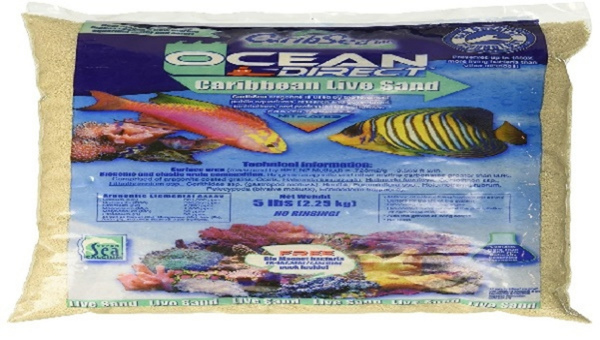
- Fluval Sea Aquarium Sand: The Fluval Sea Aquarium Sand is a regular sand perfect for Damselfish aquariums. It is made of natural quartz, which gives it a beautiful sparkle. This sand is also affordable and a great addition to any aquarium.
Plants
As Damselfish come from tropical waters, they prefer live plants in their aquarium. Live plants help to create a natural environment for your fish and can also help to filter the water.
Following are some good plants for Damselfish aquariums:
- Anacharis: Anacharis is a fast-growing plant that provides cover and hiding places for your fish. It can also help to filter the water and is very easy to care for.
- Hornwort: Hornwort is a fast-growing plant that provides cover and hiding places for your fish. It can also help to filter the water and is very easy to care for.
- Java Fern: Java Fern is a slow-growing plant that provides cover and hiding places for your fish. It is straightforward to care for and does not require much light or nutrients.
Ornaments
As Damselfish come from tropical waters, they prefer live plants and decorations in their aquarium. Live plants help to create a natural environment for your fish and can also help to filter the water. Decorations provide hiding places for your fish and make your aquarium more visually appealing.
Also, check Cherry Barb Fish: Care, Tankmates, Lifespan, Breeding & All
Following are some good decorations for Damselfish aquariums:
- Tetra Aqua Art Discovery Line Rock Cave: The Tetra Aqua Art Discovery Line Rock Cave is a natural-looking rock cave that provides hiding places for your fish. It is made of safe, non-toxic materials and is very easy to install.
- Aqueon Driftwood Aquarium Decoration: The Aqueon Driftwood Aquarium Decoration is a natural-looking driftwood that provides hiding places for your fish. It is made of safe, non-toxic materials and is very easy to install.
- Zoo Med Naturalistic Terrarium Moss: The Zoo Med Naturalistic Terrarium Moss is a natural-looking moss that can be used to decorate your aquarium. It is safe for all aquariums and is very easy to care for.
Water Changes
It is important to make water changes in your Damselfish aquarium regularly. Water changes help to remove harmful toxins from the water and can also help to keep the water quality high. It is recommended to do a water change of 25% every week.
To do a water change, follow these steps:
- Turn off the power to your aquarium.
- Remove any fish or other animals from the aquarium.
- Use a siphon or gravel vacuum to remove 10-15% of the water from the aquarium.
- Replace the removed water with fresh, clean water.
- Turn the power back on to your aquarium.
- Add your fish or other animals back into the aquarium.
You may also check Silver Dollar Fish 101: Care, Diet, Appearance, Breeding & All
Cleaning the tank
You should perform a partial water change of 25% every other week. You will also need to vacuum the gravel and clean the filter media. Rinse the filter media in old tank water to prevent disrupting the beneficial bacteria colony.
To clean the tank, you will need the following:
- A sponge: A sponge can be used to wipe down the inside of the tank.
- A toothbrush: To clean the filter, we will use a toothbrush.
- Freshwater: You will need fresh water to rinse off the sponge and toothbrush.
The steps for cleaning the tank are as follows:
- Remove the fish from the tank and put them in a temporary home.
- Remove all of the decorations from the tank.
- Use the sponge to wipe down the inside of the tank.
- Rinse the sponge and toothbrush with fresh water.
- Use the toothbrush to clean the filter.
- Rinse the sponge and toothbrush with fresh water.
- Add the decorations back to the tank.
- Add the fish back to the tank.
It is essential to clean the tank regularly to prevent the build-up of algae and bacteria. Algae and bacteria can be harmful to fish, and they can also cause the water to become cloudy.
You may also check Ryukin Goldfish Care, Lifespan, Behaviour, Diet & All
Cleaning The Filter
It is essential to clean your filter regularly. A dirty filter can cause problems for your fish.
To clean your filter, you will need the following:
- A clean bucket: This is used to hold the old water.
- A garden hose: To rinse the filter media, we will use a garden hose.
- Filter media: Filter media is used to replace the old media.
To start, you will need to remove the filter from your tank. Then, use the clean bucket to hold the old water. Next, use the garden hose to rinse the filter media.
Common Possible Diseases
There are a few common diseases that can affect Damselfish.
The most common are:
- Ich: Ich is a parasitic infection that can cause white spots on the fish. It is important to treat ich as soon as possible, as it can be fatal to fish.
The best way to prevent ich is to maintain good water quality and quarantine new fish before adding them to your tank.
- Fin rot: Finrot is an infection that can cause the fins to rot. Treating fin rot as soon as possible is essential, as it can be fatal to fish.
The best way to prevent fin rot is to maintain good water quality and quarantine new fish before adding them to your tank.
- Mouthrot: Mouthrot is an infection that can cause the mouth to rot. It is important to treat mouth rot as soon as possible, as it can be fatal to fish.
The best way to prevent mouth rot is to maintain good water quality and quarantine new fish before adding them to your tank.
Check Killifish Ultimate Care Guide, Size, Diet, Breeding, Tankmates & All
Damselfish Treatment and Medications
There are a few different medications that can be used to treat Damselfish.
The most common are:
- Ich: We can treat it with copper sulfate or formalin.
- Finrot: Finrot can be treated with metronidazole or kanamycin.
- Mouth rot: Penicillin is used to treat mouth rot.
If you think your fish may be sick, it is important to take them to a veterinarian for a check-up. A veterinarian can diagnose the problem and prescribe the proper treatment.
Advantages Of Having Damselfish In Your Tank
Some advantages and explanations of having these fishes in your tank are as follows:
- These fishes are known to control algae growth in the tank.
- These fish are also known to eat smaller fish and inverts, which can help keep the population of these animals in check.
- These fishes are also known to be good at cleaning the tank and eating unwanted food particles.
Disadvantages Of Having Damselfish In Your Tank
Some disadvantages of having these fishes in your tank are as follows:
- These fishes are aggressive and territorial. They are not recommended for community tanks.
- These fishes are also known to eat smaller fishes and inverts. So, avoiding keeping them with smaller fishes and inverts is best.
- Thus, these fishes are not recommended for beginners.
Check Best Rope Fish 101: The Complete Guide
Conclusion
In conclusion, Damselfishes can be a good addition to your aquarium if you are willing to provide them with the care they need. Just be sure to do your research beforehand and avoid keeping them with smaller fishes and inverts to prevent any problems, and you should be fine.
Thus, these fishes are not recommended for beginners. If you are experienced with aquariums and willing to provide Damselfishes with the care they need, they can make a good addition to your tank.
Just be sure to research beforehand and avoid keeping them with smaller fishes and inverts to prevent any problems. Thanks for reading!



